
-
March 2020 – Tudor Life – Music and Drama

-
Teasel’s Tudor Trivia – Shrove Tuesday

Today is Shrove Tuesday, so Teasel and I thought we’d take the opportunity to tell you all about Shrovetide – Shrove Sunday, Collop Monday and Shrove Tuesday – and how it was celebrated in Tudor times.
[Read More...] -
25 February – Elizabeth I is excommunicated

On this day in Tudor history, 25th February 1570, Pope Pius V issued the papal bull “Regnans in Excelsis”. This bull not only excommunicated Queen Elizabeth I, it also freed her Catholic subjects from their allegiance to her and called on the English people to disobey her orders, mandates and laws. It threatened excommunication for those who did obey her.
It put Elizabeth I in danger and it put Catholics in an impossible situation.
Find out more about the bull and its impact in today’s talk.
[Read More...] -
24 February – Katherine Howard, Elizabeth I’s good friend
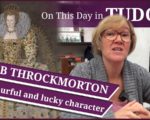
On this day in Tudor history, 24th February 1603, Katherine Howard (née Carey), Countess of Nottingham, died at Arundel House.
Katherine was a close friend of Queen Elizabeth I and it is thought that grief over her friend’s death had a major impact on the queen’s own health, for she died just a month later.
Find out who Katherine was, how she rose to be the queen’s good friend, and also hear about a myth associated with her in today’s talk.
[Read More...] -
23 February – Job Throckmorton, a colourful and lucky character
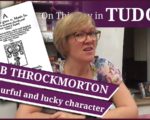
On this day in Tudor history, 23rd February 1601, religious pamphleteer and Member of Parliament, Job Throckmorton, was buried at Haseley in Warwickshire.
Job was known for his alleged involvement in the “Marprelate Controversy”, a pamphlet war, and also for his colourful Parliamentary speeches, which nearly got him into trouble. He was lucky to escape imprisonment and worse!
Find out more about Job Throckmorton in today’s talk.
[Read More...] -
Six Wives – True or False Quiz Part 2
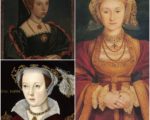
This week’s Sunday fun is a true or false quiz testing your knowledge on Henry VIII’s six wives. Part 2 focuses on Anne of Cleves, Catherine Howard and Catherine Parr.
Good luck!
[Read More...] -
22 February – Marie de Guise, who avoided marrying Henry VIII!
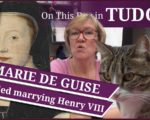
On this day in Tudor history, 22nd February 1540, twenty-four-year-old Marie de Guise, or Mary of Guise, queen consort of King James V of Scotland, was crowned queen at Holyrood Abbey.
Did you know that Henry VIII was keen on making Marie de Guise his fourth wife? She declined, saying that her neck was small! Instead, she married James V.
Marie was, of course, the mother of Mary, Queen of Scots, and you can find out more about her in today’s talk.
[Read More...] -
21 February – Ambrose Dudley, Earl of Warwick
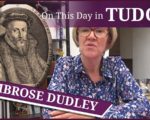
On this day in Tudor history, 21st February 1590, Ambrose Dudley, 3rd Earl of Warwick, Master of the Ordnance and Privy Councillor, died at Bedford House on the Strand.
Ambrose had been a loyal royal servant and was a member of that famous Tudor family, the Dudleys, with his father being John Dudley, Duke of Northumberland, and his brother being Robert Dudley, Earl of Leicester.
Find out more about Ambrose Dudley’s life and career in today’s talk.
[Read More...] -
Claire Chats – Researching individual people
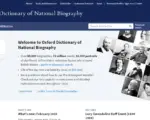
I’ve been super busy researching for the book that I’m writing with Owen Emmerson on the families and people that have owned Hever Castle through the ages, and I thought I’d share with you how I go about starting such a project. I hope you find it useful.
[Read More...] -
20 February – The hanging of Lady Hungerford

On this day in Tudor history, 20th February 1523, Agnes, or Alice, Lady Hungerford, was hanged at Tyburn.
Agnes was said to have “procured” her servants to murder her first husband, John Cotell, who was strangled before being thrown into the furnace of Castle Farley. A dastardly deed.
Find out exactly what happened in today’s talk.
[Read More...] -
19 February – The Rose Theatre, an Elizabethan playhouse

On this day in Tudor history, 19th February 1592, the Rose Theatre, an Elizabethan play house built by Philip Henslowe, was opened on Bankside in London.
Plays performed at the theatre included Shakespeare’s “Henry VI Part 1” and “Titus Andronicus”, Kyd’s “Spanish Tragedy”, and Marlowe’s “Doctor Faustus”, “The Jew of Malta” and “Tamburlaine the Great”. But, unfortunately, the Rose Theatre was abandoned by 1605.
Find out more about the Rose Theatre in today’s talk.
[Read More...] -
Ben Jonson (1572-1637)
Ben Jonson was a poet and a playwright, born on 11th June 1572, in the reign of Elizabeth I. Jonson was of Scottish descent and throughout his life maintained a great interest in Scotland and his ancestry. He was brought up by his recently widowed mother and had quite a poor upbringing. His father was a clergyman, and thus his wages would not have been substantial, nor would he have left a lot to his wife and son upon his death. When Jonson was still a young boy, his mother re-married, marrying a bricklayer, and they moved to Hartshorn not far from Charing Cross. The bricklayer in question is believed to have been Robert Brett, a man comfortable, if not overly wealthy, who had risen to become master of the Tyler and Bricklayers’ Company by 1609.
Ben Jonson attended a small school near Hartshorn Lane, learning to read and write. At approximately the age of seven, he was sent off to Westminster School and studied under William Camden, the school’s second master. Jonson evidently had a positive experience learning under Camden, speaking of him as a ‘friend for ever.’ At Westminster, he learned the art of rhetoric and was educated in the Classics, learning to translate Greek and Latin into English. Furthermore, Camden also encouraged his pupils to create their own prose in English, something which would have a profound effect on young Ben Jonson.
[Read More...] -
18 February – The Ridolfi Plot against Elizabeth I

On this day in history, 18th February 1612, Italian banker Roberto di Ridolfi died in Florence, Italy, aged 80.
Amazingly, he died a natural death even though he’d been the brains behind the Ridolfi Plot, a plot to depose Queen Elizabeth I and to replace her with Mary, Queen of Scots, thereby restoring Catholicism in England.
Find out more about Ridolfi and his famous plot in today’s talk:
[Read More...] -
17 February – Love at first sight for Mary, Queen of Scots?
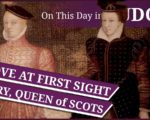
Well, ok, perhaps love at second or third sight!
On this day in Tudor history, Saturday 17th February 1565, Mary, Queen of Scots, met and fell in love with Henry Stuart, Lord Darnley, at Wemyss Castle in Scotland. Just over 7 months later, the couple got married.
Find out more about the background of this meeting between Mary, Queen of Scots and Lord Darnley, Mary’s thoughts on Darnley, and what happened next, in today’s talk.
[Read More...] -
16 February – Sir William Stanley is executed
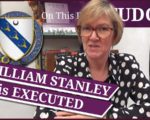
On this day in Tudor history, 16th February 1495, Sir William Stanley, administrator and landowner, was executed for treason on Tower Hill.
Stanley is, of course, remembered for his key role at the Battle of Bosworth Field in August 1485, when he and his brother chose to support Henry Tudor and brought their troops onto the battlefield at a critical stage. So how did Sir William Stanley go from being a loyal supporter of Henry VII to being executed for treason? Find out in today’s talk.
[Read More...] -
Six Wives – True or False Quiz Part 1
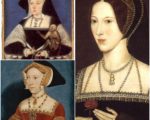
This week’s Sunday fun is a true or false quiz testing your knowledge on Henry VIII’s six wives. Part 1 focuses on Catherine of Aragon, Anne Boleyn and Jane Seymour.
Good luck!
[Read More...] -
15 February – Galileo, the Father of Modern Science

On this day in Tudor history, 15th February 1564, the Italian physicist, mathematician, astronomer, and philosopher, Galileo Galilei, was born in Pisa, Italy.
Galileo was one of the central figures of the Scientific Revolution and has been referred to as “the Father of Modern Science”, “the Father of Modern Physics” and “the father of modern observational astronomy”, but what exactly did he do and how did he end up getting into trouble with the Inquisition?
Find out in today’s talk.
[Read More...] -
Teasel’s Tudor Trivia – Valentine’s Day

Happy Valentine’s Day! Yes, it’s the day of love, and Teasel and Claire are here to tell you how medieval and Tudor people celebrated Valentine’s Day.
Do you celebrate Valentine’s Day? If so, please do share how you woo your loved one.
[Read More...] -
14 February – Being a royal favourite doesn’t save you
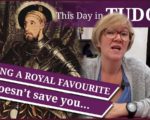
On this day in Tudor history, 14th February 1539, Sir Nicholas Carew, a royal favourite for over 20 years, was tried for treason after being implicated in the Exeter Conspiracy. Spoilers – his trial didn’t go well.
But how did a man who’d been in royal favour for so long come to such a sticky end? Find out in today’s talk.
[Read More...] -
Tudor love stories
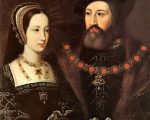
Happy Valentine’s Day!
Today, I’m celebrating the day of love with a Claire Chats talk on Tudor love stories. In a period when arranged marriages were the norm for the upper classes, there were still some examples of loving marriages and also star-crossed lovers.
[Read More...] -
13 February – Bess of Hardwick

On this day in history, 13th February 1608, prominent Tudor noblewoman and one of the richest people in England, Elizabeth Talbot, Countess of Shrewsbury, more commonly known as Bess of Hardwick, died at her home at Hardwick.
Bess of Hardwick is known for her building projects, which included Chatsworth and Hardwick Hall, her beautiful needlework and the fact that she and Shrewsbury were guardians of the captive Mary, Queen of Scots.
Find out more about this fascinating Tudor lady in today’s talk.
[Read More...] -
12 February – Blanche Parry, a mother figure to Elizabeth I

On this day in Tudor history, 12th February 1590, Blanche Parry, died at the age of 82. She had served Queen Elizabeth I loyally from Elizabeth’s birth in 1533,and had been a constant in the queen’s life.
Find out more about this interesting lady and how she served her queen in today’s talk.
[Read More...] -
11 February – Success for George Boleyn

On this day in Tudor history, 11 February 1531, the ecclesiastical assembly known as convocation granted King Henry VIII the title of “singular protector, supreme lord, and even, so far as the law of Christ allows, supreme head of the English church and clergy”.
The person responsible for persuading convocation to grant the king this title was Anne Boleyn’s brother, George Boleyn, Lord Rochford. It was a big responsibility for the young diplomat and courtier.
Find out more about what happened in today’s talk.
[Read More...] -
10 February – Catherine Howard goes to the Tower
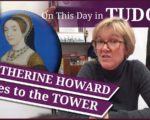
On this day in Tudor history, 10th February 1542, Catherine Howard, King Henry VIII’s fifth wife, was escorted by barge from Syon House, where she’d been kept since November 1541, to the Tower of London in preparation for her execution.
Sadly, the queen would have seen the heads of her former lover, Francis Dereham, and her sweetheart, Thomas Culpeper, as she made her way to the Tower – a reminder of her own fate.
Find out more in today’s talk.
[Read More...] -
9 February – An awful end for a bishop
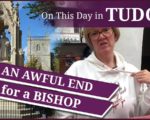
Warning – Contains a description of a burning at the stake.
On this day in history, 9th February 1555, Protestant John Hooper, Bishop of Gloucester and Worcester, and former Cistercian monk, was burned at the stake for heresy in Gloucester.
It was an awful execution due to green faggots being used, and John Foxe writes of there being three attempts over a period of 45 minutes. Awful, just awful.
[Read More...] -
February Birthdays and Feast Days Crossword Puzzle
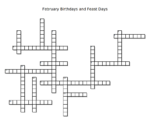
Happy Sunday! I hope you’ve had a good week. This week’s Sunday puzzle is a crossword puzzle testing your knowledge of Tudor people born in the month of February, along with February feast days.
Simply click on the link or image below to open and print out the puzzle.
[Read More...] -
8 February – The Queen’s favourite rebels

On this day in Tudor history, 8th February 1601, Robert Devereux, 2nd Earl of Essex and Queen Elizabeth I’s former favourite, did a rather foolish thing and raised a rebellion against the queen and her council.
Spoilers: It didn’t go well and he ended up being executed as a traitor.
Find out exactly what happened in today’s talk.
[Read More...] -
7 February – Sir Thomas More

On this day in history, 7th February 1477 or 1478, Sir Thomas More, Henry VIII’s Lord Chancellor, was born in London.
More had once wanted to be a monk but ended up being one of the most well-known statesmen of the Tudor period. Unfortunately, Sir Thomas More came to a sticky end after refusing to sign the oath recognising Henry VIII as the supreme head of the church in England, and was executed in 1535 as a traitor.
Find out all about More’s rise to power, how he fell, and what he told his son-in-law about the king, in today’s talk.
[Read More...] -
Ludlow Castle – Roving Reporter
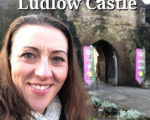
This month, Philippa Brewell, our roving reporter, has been to Ludlow Castle in Shropshire. It’s an impressive Norman castle, now in ruins and it has a strong connection to the Tudors.
[Read More...] -
6 February – Thomas Cutwode and his dodgy works
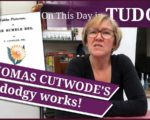
On this day in Tudor history, 6th February 1561, poet Tailboys Dymoke (pseudonym Thomas Cutwode) was baptised at Kyme in Lincolnshire.
Dymoke, or Cutwode, is known for his allegorical poem, The Bumble Bee, a political satire which was apparently rather dodgy! He also got into trouble for writing a slanderous play and poem. An interesting man who liked to play with fire!
[Read More...]
